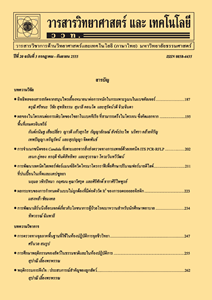การเตรียมรีเอเจนต์ CuSO4 และ Cu(NO3)2 จากอะไหล่รถยนต์ใช้แล้วและของเสียจากห้องปฏิบัติการ
Main Article Content
Abstract
บทคัดย่อ
ในงานนี้เป็นการเสนอแนวคิดสำหรับห้องปฏิบัติการทั่วไปในการลดค่าใช้จ่ายในการจัดซื้อสารเคมี รวมถึงการลดการปนเปื้อนของโลหะหนักลงสู่สิ่งแวดล้อม โดยการแยกโลหะทองแดงออกจากของเสียเพื่อเตรียมเป็นสารเคมีด้วยขั้นตอนที่ง่ายและประหยัด ของเสีย 2 ชนิด ซึ่งประกอบด้วยอะไหล่ใช้แล้ว เช่น ไดสตาร์ท ไดชาร์จ และของเสียจากห้องปฏิบัติการซึ่งมีทองแดงเป็นองค์ประกอบถูกนำมาใช้ในงานนี้ ทองแดงที่อยู่ในอะไหล่เก่าจะถูกแกะออก นำมาทำความสะอาดและตัดให้เป็นชิ้นเล็ก ๆ สำหรับของเสียจากห้องปฏิบัติการจะถูกนำมาแยกโลหะทองแดงด้วยเทคนิคซีเมนเตชันโดยใช้โลหะสังกะสีเป็นตัวรีดิวซ์ จากนั้นนำโลหะทองแดงที่ได้มาทำปฏิกิริยากับ 30 % H2O2 และ conc. H2SO4 ด้วยอัตราส่วนที่เหมาะสมที่ได้ศึกษาคือ Cu : H2O2 : H2SO4 เท่ากับ 3:10:3 (g:mL:mL) ในขณะที่ Cu(NO3)2 ถูกเตรียมได้จากปฏิกิริยาของทองแดงกับ conc. HNO3 ที่อัตราส่วน Cu : HNO3 เท่ากับ 1:5 กระบวนการทั้งหมดเกิดขึ้นที่สภาวะปกติโดยปราศจากการใช้เครื่องมือราคาแพงและซับซ้อน ผลึกทั้ง 2 ชนิด จะเกิดขึ้นในเวลาเพียง 2-3 วัน ร้อยละผลผลิตที่ได้ของ CuSO4 และ Cu(NO3)2 คือ 38.8 และ 64.7 % ตามลำดับ จากการนำสารเหล่านี้ไปใช้เป็นรีเอเจนต์ในการวิเคราะห์ทั้งเชิงคุณภาพและเชิงปริมาณพบว่าไม่มีความแตกต่างกันระหว่างสารเหล่านี้กับสารที่มีจำหน่ายทั่วไป
คำสำคัญ : อะไหล่ใช้แล้ว; ของเสียจากห้องปฏิบัติการ; คอปเปอร์(II)ซัลเฟต; คอปเปอร์(II)ไนเตรต
Abstract
In this work, we propose the idea for general laboratory to diminish the budget of chemical supplying and to decrease the contamination of heavy metals into environments by recovering the copper from wastes in order to transform into chemicals with economical and simple procedure. Two categories of wastes, used spare parts like starter motor and alternator, and laboratory wastes which contained copper, were employed. Copper wire inside spare parts was demounted, cleaned and cut into small pieces. For laboratory wastes, metallic copper was recovered via the cementation process, using zinc as the reductant. Next, the obtained copper reacted to 30 % H2O2 and conc. H2SO4 with the studied suitable ratio of Cu : H2O2 : H2SO4 at 3:10:3 (g:mL:mL), while Cu(NO3)2 was prepared from the reaction of copper and conc. HNO3 at the ratio of 1:5. All processes were done at the ambient without any complicate and expensive apparatus. Both crystals occurred in a few days. Percent yields of CuSO4 and Cu(NO3)2 were 38.8 and 64.7 %, respectively. From the application of these chemicals as the reagent in both qualitative and quantitative analysis, the results are not different in using these experimented chemicals and the commercial available ones.
Keywords: used spare parts; laboratory wastes; CuSO4; Cu(NO3)2


